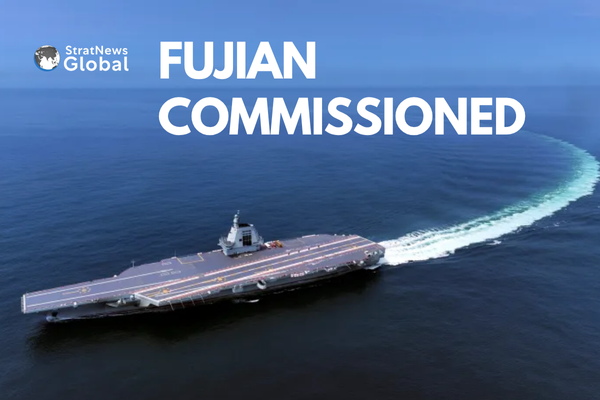China has formally commissioned its newest and most advanced aircraft carrier, the Fujian, marking a major milestone in its military modernisation drive. However, defence analysts and diplomats say the vessel faces significant technical and operational hurdles before it can be declared fully combat ready.
A New Phase in China’s Naval Expansion
President Xi Jinping presided over the commissioning ceremony in Hainan province on Wednesday, where he presented the navy’s flag and toured the Fujian, according to the official Xinhua news agency. The carrier, China’s third, features a flat flight deck equipped with electromagnetic catapults, a key technological leap from the ski-jump ramps used on the earlier Liaoning and Shandong carriers.
The Fujian can host more aircraft, including heavier and better-armed fighter jets. During sea trials this year, China successfully tested carrier launches of its new J-35 stealth fighter, the KJ-600 early-warning aircraft, and upgraded versions of the J-15 fighter. State media hailed the Fujian as a “milestone” in China’s naval ambitions.
Crew members stood in formation on deck as Xi departed, pledging to “obey the Party’s command, be able to fight and win, maintain exemplary conduct,” according to reports.
Still Years from Full Combat Readiness
Military observers say the carrier is still in early testing phases. Ben Lewis, founder of the open-source platform PLA Tracker, said it could take at least another year before the Fujian becomes fully operational. “Despite nine sea trials this year, they are working with almost entirely new platforms top to bottom,” Lewis said.
Footage released by state media showed J-15s taking off from the Fujian’s catapults without weapons, suggesting that flight operations remain in a developmental stage. Singapore-based defence scholar Collin Koh said the deployment of the KJ-600 early-warning aircraft was particularly important for extending the range and coordination of China’s naval forces.
Strategic Role and Limitations
Since China’s first carrier, the Liaoning, was commissioned in 2012, Beijing has largely used its carriers as training platforms. However, recent deployments east of Japan and toward Guam suggest that China’s navy is beginning to expand its operational reach.
Unlike U.S. nuclear-powered carriers, the Fujian runs on diesel fuel, limiting its range. Analysts estimate it must refuel after travelling about 10,000 nautical miles (18,520 km), whereas American carriers can remain at sea for years.
The Pentagon’s 2023 report on China’s military noted that the Fujian and future carriers would significantly enhance China’s power projection capabilities, allowing for the deployment of electronic warfare and anti-submarine aircraft. “This will increase the striking power of a potential People’s Liberation Army Navy carrier battle group when deployed to areas beyond China’s immediate periphery,” the report stated.
Koh added that the Fujian would likely serve both a propaganda and strategic purpose. “This is potentially a game changer for China,” he said. “But there are a lot of capabilities here they’ve still got to test and finesse including how they would best deploy it in a Taiwan conflict.”
(with inputs from Reuters)





